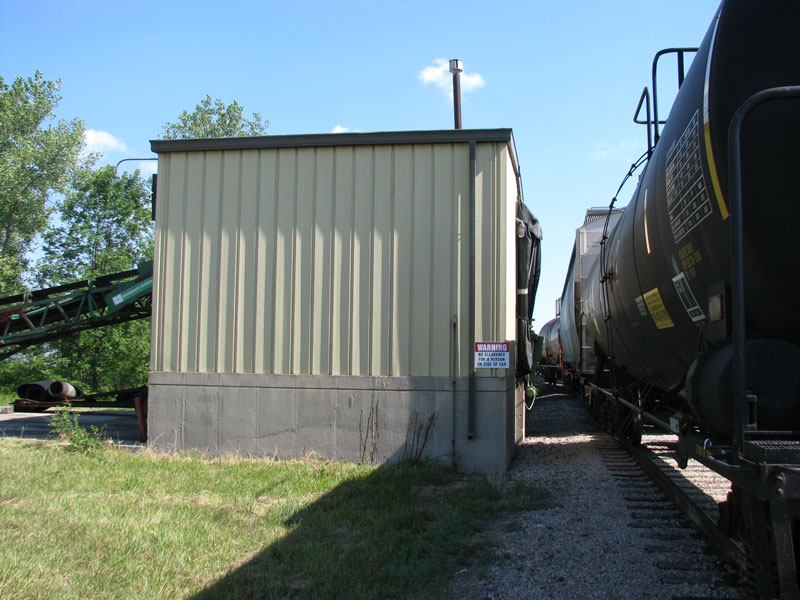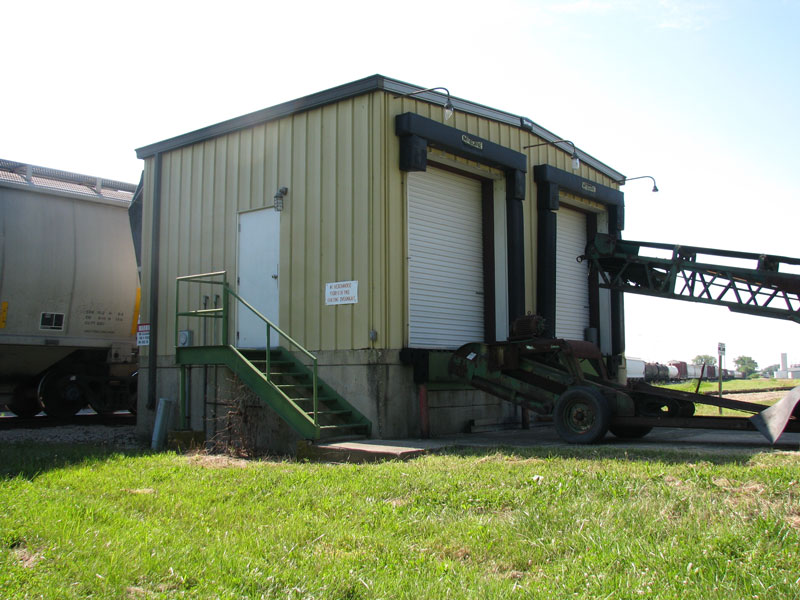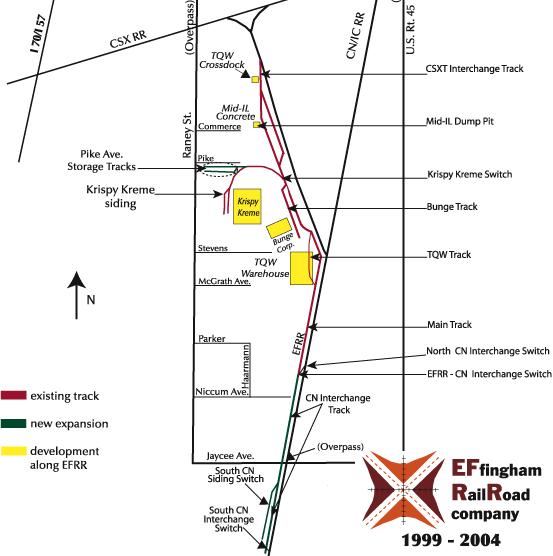Posts: 1,263
Threads: 45
Joined: Feb 2010
Here are some shots I took of the TQW Crossdock facility on the Effingham Railroad in Effingham, IL, this past Friday (20100625). I had taken slides of this structure a few years ago when the EFRR first started operations, but can't locate them now, so on my way through Effingham I stopped and took these shots.
Always thought this would make an interesting small structure for a team track and may yet try to include a model of it on whatever I end up building for my HO layout. As you can tell, this structure is no longer in use and is rather difficult to get to these days. Once they constructed the large TQW warehouse (about 1/2 south of here) there was probably no longer any need for this building.
Although I didn't have anything with me to take measurements, the structure is roughly 20 feet deep and about 25-30 feet wide. There are two doors on the backside where you could park two trucks side by side and a single door on the front or rail side. A single personnel door is located on the north side. Would be very easy to kit bash this structure from a Pikestuff kit.

Back or west side of the TQW Crossdock - Note that the conveyor has nothing to do with this structure - just a place to put it out of the way.

North side (depending on how you view the structure) with the personnel door and stairs

South side of the structure.
Sorry I couldn't get shots of the track side, but as you can see, the EFRR is using about every track in the industrial park for car storage these days.
Ed
"Friends don't let friends build Timesavers"
Posts: 3,683
Threads: 118
Joined: Jan 2009
That is very neat. I have never seen anything like it before. It is so small, it hardly justifies itself in todays modern era... which is why it is no longer in use I suppose. Any idea when the structure was built and when it was in used?
I assume the structure was used for less-than-carload transfer of goods from rail to truck. Would be very easy to model this.
Three Foot Rule In Effect At All Times
Posts: 3,262
Threads: 115
Joined: Dec 2008
Gary S Wrote:That is very neat. I have never seen anything like it before. It is so small, it hardly justifies itself in todays modern era... which is why it is no longer in use I suppose. Any idea when the structure was built and when it was in used?
I assume the structure was used for less-than-carload transfer of goods from rail to truck. Would be very easy to model this.
Gary,Actually transloading from a single "team track" is still being done today..Modern railroads hasn't change basic operations.
The new "freight house" is now called a rail to truck distribution centers which can be specialized to handle certain commodities.
All railroads have transload services..
Larry
Engineman
Summerset Ry
Make Safety your first thought, Not your last! Safety First!
Posts: 3,683
Threads: 118
Joined: Jan 2009
Brakie, I was wondering about the smallness of such a structure! I assume that most modern transload facilities are quite huge?
Three Foot Rule In Effect At All Times
Posts: 1,263
Threads: 45
Joined: Feb 2010
Gary;
This crossdock / transload structure was built by the Effingham Railroad in 1999, when they commenced operations at the Effingham Industrial Park. Not sure how long the structure was in use but was used for a least a couple of years until the large TQW warehouse was constructed on the line. Here's a map of the EFRR that shows the location of the crossdock structure and all of the EFRR trackage.

Note, that since this map was drawn, that all the green "proposed" trackage has been built. Also it should be noted that some of their original customers in the industrial park are no longer there. Krispy Creme and Bunge Grain are both gone - replaced by other companies. As I noted in my initial post, most of the industrial spurs seem to be being used for car storage. An interesting short line, but it doesn't lend itself to modeling as a shelf layout I'm sorry to say.
Ed
"Friends don't let friends build Timesavers"
Posts: 3,683
Threads: 118
Joined: Jan 2009
Thanks for the map and the explanation. Very good stuff! 
The small structure was just a temporary place for loading/unloading until the bigger structure was built?
Also, what would be the objections to using this as a shelf layout. It looks fairly linear....
Three Foot Rule In Effect At All Times
Posts: 5,263
Threads: 195
Joined: Apr 2009
I guess they ware unloading some stuff from boxcars/reefer to trucks and had problems with the weather. Might be cold weather with snow ruined some delicate goods or the hot summer made it impossible to keep food frozen. The solution is a warehouse that can't store anything but provides the "usual" protected loading docks for rail and street vehicles.
Reinhard
Posts: 3,262
Threads: 115
Joined: Dec 2008
Gary S Wrote:Brakie, I was wondering about the smallness of such a structure! I assume that most modern transload facilities are quite huge?
Most of them are large but,there are small one track affairs that unloads from freight car to truck..Items like plastic or rubber pellets,some types of chemicals,road salt,lumber.
Larry
Engineman
Summerset Ry
Make Safety your first thought, Not your last! Safety First!
Posts: 1,263
Threads: 45
Joined: Feb 2010
Gary S Wrote:The small structure was just a temporary place for loading/unloading until the bigger structure was built?
Also, what would be the objections to using this as a shelf layout. It looks fairly linear.... Can't say if the crossdock was built to be temporary, but does seem to have stopped being used when the much larger warehouse was constructed. I've stopped by this operation several times over the years since it came in to being and never caught them working or seen anything spotted at the crossdock. Originally, their beautiful SW-1200(?) sat by the crossdock, but is now kept inside the large warehouse.
As for modeling this line, it certainly has/had potential for an interesting switching operation, but if I had to straighten out the Krispy Creme and Pike Ave storage tracks to make it fit a shelf area, it would loose it's "flavor". Just my opinion. I suppose you could have that portion of the layout jut out into the isle far enough to make it resemble the prototype track arrangement.
Now of course a fellow could model their other operation in nearby Greenville, IL - the Illinois Western. One switch, 1100 feet of track and an ex-IC GP-10. Best description I could give this operation, is a "Short Line That Hopes To Be..."
Ed
"Friends don't let friends build Timesavers"
Posts: 46
Threads: 1
Joined: Jun 2010
Small buildings like these are constructed over a concrete dock at door height to provide a place out of the weather where a forklift can operate reliably to load/unload boxcar/reefer traffic to/from trucks. These are designed as "pilot" structures to:
1.Entice new customers onto a shortline who after increasing their rail provided business, then build their own rail served facilities (production or warehouse or both) on either railroad or industrial park property. or they:
2. Can handle short time or "one shot" business not requiring a potential permanent structure often from a facility off line and too large to re-locate.
These structures are relatively in-expensive to build and are usually not intended for storage of product.
I have operated/managed shortlines where we did not even have the luxuary of such a structure or any other building but did all transloading of cars and maintaining of locomotives on the ground in all kinds of weather or used a portable ramp, pump or conveyor. When starting up a shortline, the emphasis is on spending your money to rehab track and using the simplest/least expensive methods to build additional business fast through transloading to supplement the existing customer base. Nice, new fancy buildings and spiffy, paint, jobs for locomotives/cabooses come later when (if ever) the company becomes profitable.
With this in mind I am often humored when modelers insist on building large modern structures for the customers on their layouts. Truth be told, many shortline customers have minimal facilities and many can be duplicated simply on a shelf layout. A spare track graded on both sides can handle scrap gons, flats of lumber/drywall, a location with catch pads between the rails and a small portable pump can handle tank car/covered hopper traffic, a simple pit under the rails with portable conveyer can handle aggregate, salt, minerals, and a portable dock/forklift can handle boxcar reefer business. Just some model ideas for facilities I have used in prototype operations.
Barry
Posts: 4,161
Threads: 174
Joined: Dec 2008
Thank you Barry and welcome!
That is a nifty structure that would add a lot of interest to a contemporary layout. 
Ralph
Posts: 1,897
Threads: 40
Joined: Dec 2008
Express Trak at Redondo Junction near the Loa Angeles Union Station had a similar sized structure where they transloaded boxes of oranges from trucks to mechanical reefers. Since the weather in LA is pretty nice year round, the structure had no sides, just a platform for the fork lift and a ramp and roof to provide shade or keep the rain off. It was also on wheels so it could be moved and spotted to allow loading two rail cars without having to have the switcher come down and move them around. An aluminum ramp that spanned the space between the dock and the car would be flipped up and the fork lift would hook on and pull the dock to the next car.
Posts: 3,683
Threads: 118
Joined: Jan 2009
Thanks for all the commentary and explanation from everyone. This would be a cool thing to model. I also like the idea of it being on wheels. Haven't seen anything like that around here, although I did post some photos of a tank car unloading apparatus on wheels. They use it to pump liquids from tank cars into tanke trucks. Nothing there but a siding. The used a pick-up truck to haul the unloader around.
Three Foot Rule In Effect At All Times
Posts: 105
Threads: 27
Joined: May 2010
The Finger Lakes Rwy. has a building exactly like that one you photographed. For a moment there I thought it was the same exact building. They have a customer in Auburn, NY that transloads beer from boxcars to trucks. Inside that building is room enough to store a forklift and two transfer docks. Thought that might help.
Doing my best to stay on track and to live each day to it's fullest, trying not to upset people along the way. I have no enemies.....just friends who don't understand my point of view.
Steve
Let's go Devils!
Posts: 1,263
Threads: 45
Joined: Feb 2010
FedEx13 Wrote:The Finger Lakes Rwy. has a building exactly like that one you photographed. For a moment there I thought it was the same exact building. They have a customer in Auburn, NY that transloads beer from boxcars to trucks. Inside that building is room enough to store a forklift and two transfer docks. Thought that might help. Transloading beer at this crossdock may have been one of its primary functions. The EFRR began their operations on what was known as the "Beer Track" in Effingham. Two of their other customers also received paper products (Irving Paper and Fraser Paper).
Interesting that there is another structure just like this one. I think I've located enough Pikestuff parts in my junk box to build a model of this one.
Ed
"Friends don't let friends build Timesavers"
|
 Back or west side of the TQW Crossdock - Note that the conveyor has nothing to do with this structure - just a place to put it out of the way.
Back or west side of the TQW Crossdock - Note that the conveyor has nothing to do with this structure - just a place to put it out of the way.
 North side (depending on how you view the structure) with the personnel door and stairs
North side (depending on how you view the structure) with the personnel door and stairs
 South side of the structure.
South side of the structure.




